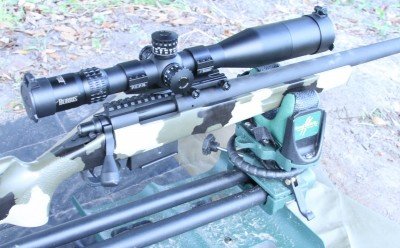
First Focal Plane scopes make calculating distance and holdover much easier than it is with regular scopes. The Burris XTR II mounted on my US Marine M40 copy from TacticalRifles.net is my test subject to explain the issues and the math.
On Optics Planet w/ Mil-Dot (Mrad) Reticle $1099:
https://www.opticsplanet.com/burris-xtr-ii-illuminated-riflescope-w-g2b-mil-dot-reticle-4-20x50mm.html
On Burris Website w/ MOA Reticle:
https://www.burrisoptics.com/scopes/xtr-ii-riflescopes-series/xtr-ii-riflescope-4-20x50mm
Riflescopes have come a long way in the last ten years. It used to be that only elite hunters paid big money for high quality scopes, and those scopes mostly came from Germany. I don’t know if patents ran out on manufacturing methods, or manufacturing just got that much better overseas, but these days there are a lot of great scopes that are crystal clear even in low light conditions, and they don’t cost big money. You can still spend over $5,000 on a riflescope, but for $1,000 to $2,000 you can get what I’ve found to be as good a scope for a lot less (and sometimes even less than $1,000). This Burris XTR II 4x-20x is made in Malaysia, and I would put it against scopes many times its cost.
More important to me, the XTR II is also one of my first experiences with a new generation of “first focal plane” or “front focal plane” inexpensive import scopes. If you have never shot with an FFP scope, they work basically the opposite of a “regular” riflescope. In a regular scope, the reticle (crosshairs or similar), stays the same size and the background zooms in and out. With an FFP scope the reticle zooms with the image and gets bigger and smaller as you zoom. See the pictures. The result is that the range estimation and holdovers for the scope are always the same.
Sounds confusing right? Well that’s because it is confusing, but if you boil out the individual parts, you’ll find that it isn’t as hard as it seems.
You may already have already tried both range estimation and holdover with your existing scope. But with a regular scope, those functions only work at a given power of the scope, usually the highest power. There are also scopes that are specifically tuned to your ammo, so your holdover at the very least is already delineated on the reticle. The most common of these are scopes that are specifically for .223 and for .308, and then there are also custom turret scopes, which are really the best if you want to keep things simple. Range estimation is not usually discussed with the very simple reticle scopes that come with hash marks for 100-1000 yards printed right into the scale.
Mil-Dot/Mrad vs. MOA
Not keeping things simple gives you the most flexibility, especially if you plan to use the same scope for different loads in the same rifle, or on different rifles. That is why the military, long distance hunters and most competitive shooters use a more general reticle with either the “mil-dot/Mrad” system, or the “MOA” system. Once you learn rules of how either system works, range estimation and holdover are easy. You have probably heard the term MOA, or “minutes of angle,” and mil-dot/Mrad, aren’t like that, so I’ll explain the difference.
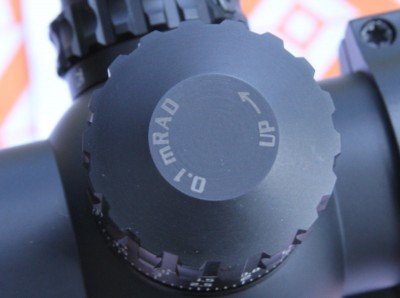
Mils, or Mrads, are slightly courser than MOAs, so the clicks on your scope are 1/10th of a mil, as compared to 1/4 of an MOA. In practice they are .36″ and .25″ at 100 yards.
MOA is figured in degrees of a circle. One “minute of angle” is 1/60th of one degree, A circle has 360 degrees in it (think of a compass), so one minute of angle spans a wedge coming out from the center of the circle measuring 1/60th of 1/360th, which is 1/21,600th (don’t worry you never use that number). One of those “minutes of angle,” coincidentally and conveniently, equals 1.047 inches at 100 yards. So when we say that a rifle shoots into one “minute of angle, it usually means that when you take a number of shots, usually 3 to 5, absent human error, all of the bullets fall within that inch. Likewise, when you click your scope that is labelled “1 click = 1/4MOA,” that means that each click will move your point of impact about 1/4 of an inch at 100 yards.
Mil-dots, or Mrads, are a different type of measurement based on “radians.” A radian is likewise a way to split up a circle, and I won’t get into the math involved, but a “mil” or “Mrad” is 1/1000th of a radian. One mil equals 3.438 minutes of angle, or 3.6 inches at 100 yards. So, since a mil/Mrad is much courser of a measurement than one MOA, generally mil/Mrad scopes are clicked in 1/10 mil/Mrad increments, or .36 inches at 100 yards as opposed to .25 inches for an MOA scope.

The Burris XTR II is a $1629 MRSP scope that you see on Amazon and Optics Planet for $1099. It is as clear at twilight as scopes costing 3-5x that.
Estimating Distance
Don’t stop reading now if you got this far. Estimating distance does require that you re-organize your brain a little bit in the way you think about your scope, but with a first focal plane scope it makes a lot more sense than with a regular scope. As you can see from the pictures, the dots on a mil-dot/Mrad scope and the lines on an MOA scope get smaller and bigger in an FFP scope, so they stay the same size relative to their surroundings. Whether you are at 4x on the XTR II or 20x, the height of a man at a given distance is going to be the same amount of dots or lines tall. Since you can see him in your scope, and estimate his height at say 6 feet, your scope can tell you exactly how far he is away.
On an MOA scope, you multiply inches times 100, divided by MOAs. That equals yards away. So say the guy is 6 feet, which is 72 inches, you divide 7200 by how many lines tall he is in the scope, call it 8 MOA. That equals 900 yards.

The question is, does the scope hold zero over the course of its magnification. To measure this, first I checked the spread on the rifle itself at 100 yards. It is better than .5MOA.
A mil-dot/Mrad scope is the same type of methodology, but it isn’t inch/yard specific. You can use it for meters also. The formula is yards or meters in height of the object, times 1,000, divided by mils/Mrads. So for the same 6 foot guy, you could say he is two yards high, times 1,000 equals 2,000, divided by 2.33 mil/Mrad (the same 8MOA when 1 MOA = .29 mil/Mrad) equals 858 yards. The same system can be used for yards to yards or meters to meters. If you estimate an AR mag well at 2.5″ wide through your scope is .5 mil. That is .069 yards (2.5/36), times 1,000 divided by .5 mil is 138 yards. Once you get it, you get it, but read it a few times and Google other ways people explain it and eventually it will sink in.
The MOA estimation is not as precise as that computed by mils/Mrad because of the 1.047 inches, not 1 inch, at 100 yards. Mils/Mrads is almost universally the preference of competition shooters and military snipers for this reason. But in recent years, with a new appreciation for high quality optics in the American shooting market, the MOA scopes have become more popular, probably because few people ever actually learn the math and we hear MOA, MOA, MOA so often in industry marketing materials. I prefer mil/Mrad scopes.
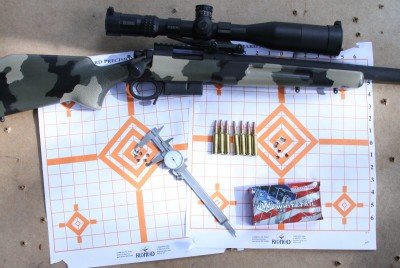
Then I tried the same scope over 7 rounds for each position on the magnification ring. 4x at 100 yards is hard for me with aging eyes, but I still managed to keep all the rounds into 1.5MOA consistently.
Calculating Holdover
Once you know your distance, any ballistics calculator will give you the holdover. I use a free calculator on my Android phone called Strelok, and I paid for a great one called Shooter. There are hundreds of others in the Play store, and several scope companies have their own app, but not Burris (Strelok has Burris reticles). I like using the non-branded apps much better, and Shooter now has a plugin to connect Kestrel weather products right to your phone.
If you have never used a ballistics calculator, check out this very basic one at Hornady. As you can see, figuring your downrange point of impact comes down to several factors that interplay with each other. The first is velocity at the muzzle. This can usually be found on your box of ammo, but note that this velocity is calculated with a certain length barrel, 24″ for a bolt gun generally. If you aren’t using a specific brand of ammo with a known velocity, or your barrel length is shorter, you may have to guestimate, or ideally buy yourself a chronograph for about $100. Your bullet itself also has a specific value that is very important, called “ballistic coefficient.” The higher the number, the easier the bullet flies through air, and either your ammo maker or if you reload, your bullet maker, will have the “BC” of the bullet listed on their website. The weight of the bullet is the third factor, and this is a factor that also figures into the BC, because a heavier weight, less pointy, bullet will have a higher BC than a light pointy bullet. Leaving any of these factors out of your ballistic calculator, or guessing at them, won’t give you good results.
Once you plug in these factors and tell the calculator the height of your scope and your original sight in distance, it will spit out a ballistics chart of some kind for you to use as a “dope card” in the field, or you can just reference your phone. Advanced calculators like Strelok and Shooter will give you a lot of other factors, which are outside the scope of this article, but as you can see, estimating distance is crucial. If you have the ability to get a digital rangefinder, it is a great way to practice estimating with your reticle.
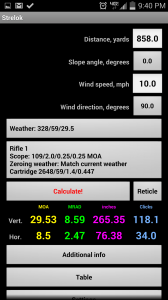
A free app like Strelok on Android can give you the holdover and windage in inches, mils/Mrads, and MOAs.
Holdover can be given in inches, mils/Mrads or MOAs. Ideally you will set your calculator to whatever you are using. The Strelok app gives you all of them, and it will show you in the reticle where to hold for your both your distance drop and horizontal windage, if you have any wind.
First Shot Hits
It may sound very precise to calculate all of these things, but even the most advanced and skilled snipers rarely make first shot hits at beyond 300 yards. As precise as the best sniper rifle can shoot, and as good as these numbers may sound, rarely do they all add up correctly. Air density, the spin of the earth, the slant angle of the shot, and a number of other factors can be calculated, but you’ll sit there all day and rarely does anyone do that comprehensively. Also, even a .5MOA rifle at 500 yards has 2.5 inches of spread from physical factors alone, so calculations for a head shot at that distance is still little more than a very educated guess, and a lot of luck.
First Focal Plane – Is it better?
If you Google reviews of FFP scopes, you’ll find that they don’t have a good reputation historically, because even though they make a lot more sense when it comes to calculations, the old scopes didn’t maintain zero along the range of magnification.
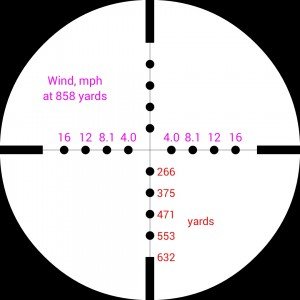
Strelok will even give you a picture of your chosen reticle with the distances and windage marked according to the dots.
Therefore, for this article, I shot the Burris XTR II with a great rifle we got from TacticalRifles.net several years ago, to test just this issue.
First I shot a few base groups, and even with my moderate skills, at 20x this gun will shoot into .5 inches at 100 yards all day. Human error (mine) is the only reason you aren’t seeing a ragged hole that you can’t even measure, because the gun is just that good. My “secret weapon” in factory ammo is the Hornady American Whitetail 150 grain you see in the pictures. For some reason it shoots great in every .308 I have fired it in.
Then I shot the same load in the same rifle at the same distance for 7 rounds, one round each at 4x, 6x, 8x, 10x, 12x, 16x, and 20x. Now granted, I am going to have a lot more “human error” at 4x at 100 yards than at 20x, but I still was able to keep all 7 rounds consistently into under 1.5 MOA, and several groups were in the 1MOA range. I can’t shoot much better than 1 MOA at 4x at 100 yards, even in my Caldwell Lead Sled.
So as much as I could measure, this Buris XTR II FFP scope shoots into the same hole along its range of magnification, to within 1 MOA at the very worst, and probably much better. This is a trait that very few people measure in scopes, and I hope to try this with a bunch more regular and FFP scopes, because all other factors somewhat equal, this is really what separates a good scope from a great scope. I am a big fan of FFP scopes, and this Burris XTR II is a keeper. I hope they let us keep it.
If you follow GunsAmerica Digest, you may remember the article before Christmas I did on scoping your M1A. In that article I tried the sister FFP scope to this XTR II called the Burris Veracity. If you look in the pictures for the XTR II and the Veracity pictures, you’ll see that this XTR II is an open turret scope meant for competition and advanced sniper work, whereas the Veracity is capped turrets, and made for more of a hunting application or sniper work where most of your shots will be within easy holdover distances. Clicking a scope like the XTR II into correct holdover and windage is an art in itself, and really requires practice. Spending money on the scope itself may seem like the hard part when it costs upwards of a grand or more, but the really hard thing is to slow down and spend the time to know your rifle, learn your ballistics, and practice using your scope so that you are a deadly combination. I’ve become a big fan of Burris scopes, and I intend to be back for more of these in depth articles on just how to use them.

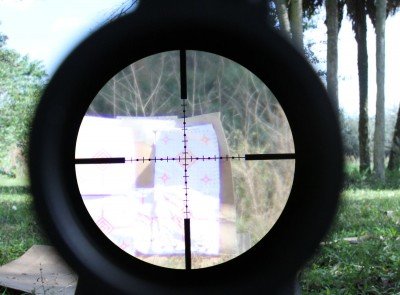
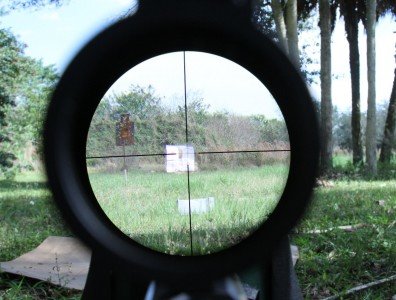
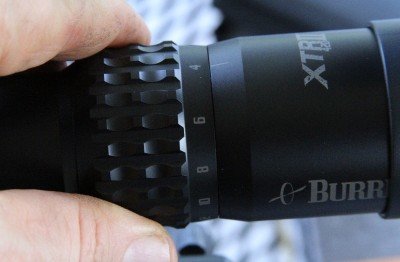
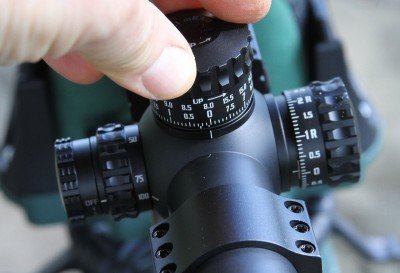
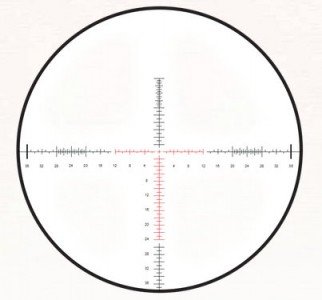
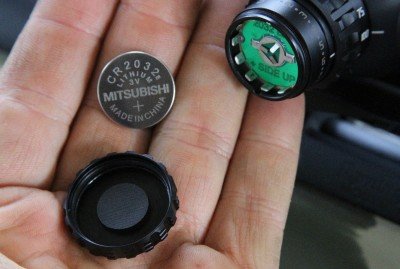
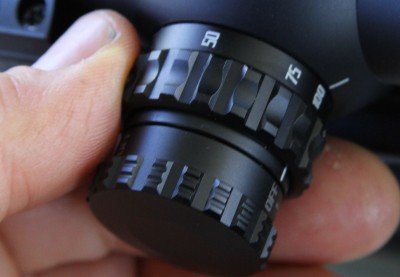
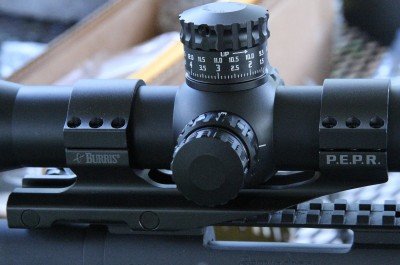
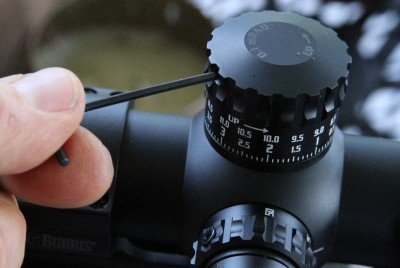
Most if not all mRAD scopes provide 1/10 mRAD adjustment per click. A MOA scope with a 1/4 moa adjustment per click. At 100 yards the mRAD adjustment moves 0.36″ ; the Moa scope with 1/4moa moves the point of impact 0.25″.
the difference, 0.36 – 0.25 = 0.11″.
A 22.caliber bullet is 0.224″ that, means the difference (0.11″) is half the diameter of a 22 caliber bullet at 100 yards.
When we learn to use our equipment we can leave the rangefinder at home or sell it and reload more ammo.
For 99.9% of people that actually own a rifle, everything in this article is a waste of time, money and treasure. The shooting world is full of over hyped pointless gadgets that, in the real world, are neither practical nor necessary. Mr.Helinsky reminds me of a 10 year old running amok in a store with no idea of what he’s looking at or what it’s for but he has to have it because it looks cool.
The entire point of hunting in this day and age has been lost on people like the writer of this blog. In case you missed it, the point is to get close enough to use your chosen weapon effectively and humanely. The point is NOT to sit back half a mile away and sling bullets with misguided hope of hitting “something”. With the rare exception of a few indigenous tribes, nobody on the North American Continent actually relies on hunting for subsistance anymore. The previous couple of generations took care of that with market hunting, over harvest and poaching. Regardless of what screwball “Preppers” and the History Channel would have you believe.
Are FFP scopes “better” than SFP scopes? Within the normal effective range of the average hunting rifle, the answer is no. If you are into punching holes and ringing gongs at 1000 yards, they can simplify the math a bit for those willing to invest the time and resources to learn how to actually use them. Which for the record, is exactly why the Military uses them.
Your money is much better spent on other things like ammo, reloading supplies, a good pair of boots, a good knife or even an extra Tag.
AMERICA is the My Dream, My Way, My Choice, My Hope, My Vote , My Right Country
We individuals exert our power with our choices….so, yes, most choices flow around two items…..cost and availability….
Prepping is a choice for your EXTRA MONEY…just as some folks build water fountains in their yards, or buy beach cottages, or time shares for vacation properties..
if a Prepper has food, medicine, water, clothing, tools, fuel….what do you call him ? Invested in his future..
now the super magnum rifle, the triple barreled 12 gauge shot thrower, even the high speed zapper rounds…all exist as someone wishing to sell something…as the seller attempts to ” prep ” his future with sales to garner money to allow him to invest for his future….
I know people who willingly spend $15,000 to take good parts out or off a Jeep, and substitute other parts and devices to allow the Jeep to cross rougher ground, climb some serious rock hills and drive in desert areas ….investing this money in their future for fun, excitement, bragging rights…..prepping for their future….
I know 5 young men : two are in training programs to become auto mechanics…prepping..
.one is in a college program heading toward a Doctor of Medicine and Specialty in Heart Surgery….prepping….
one is in a program to complete his course work and become an Electrical Engineer with a Minor in Computers….
and the 5th young man …he is working through his course studies toward a degree as a Chemical Engineer and a Medical Course which will specialize toward MicroBiology, cell replication, and possibly regrowth of human limbs and / or teeth….PREPPING….PLANNING….INVESTING….
yes, most any reasonable telescope will allow you to kill game animals…yes, some serious shooting practice will help to old squeeze and connect with the strike point close to our aiming point…….yes, reloading will allow more shooting…and decrease the litter of our fields and woods…in short, I agree…we live within our means….we purchase a second or fifth choice item rather than the top of the line, gadget loaded thingey due to our financial status….but let us all enjoy the effort of the guy who steps three paces past our limits…he opens new areas, new dreams, feeds hope….I distrust exposed extractors as part of pistols….yep, the Browning Hi Power 9mm 13 shot pistol has the exposed extractor….and Smith and Wesson put an exposed extractor in their 1911 type pistol…which gives me and you a choice….I choose the quick replacement, replace only one item, original extractor of the 1911 /1911a1 pistol…..you makes your choice….I choose the Glock 19 over the Smith and Wesson Shield….do not like cables and two part triggers if I can get a one part trigger….I choose Smith and Wesson revolvers of J frame, K frame, and L frame as they more closely fit my hand size…the N frame is just too out of my hand size…yeah, I could cut it up…weld it up…add some metal here, change that there…make of it a K frame grip and trigger pull for my hand, and a Triple lock up with the addition of a cylinder pin lock in the frame….but would you trust MY Choices ?….not Your Choices…but MINE ? or do you want to make your own choices….AMERICA is the My Dream, My Way, My Choice, My Hope, My Vote , My Right Country
I don’t hunt, I shoot for fun. Long-range, 500-1000+ yards. I’m not sure why you would automatically assume everyone visiting this page is a hunter and therefore the supplied information has no bearing. Boots, knives and tags of any kind would all be a waste of money to me. A good FFP scope that can hit a flea off a dogs back at 1000 yds would be much more meaningful to me.
It may be your opinion that the XTRII series is the equivalent of much more expensive scopes but you’re just plain wrong. Have you spent time behind a Kahles, Schmidt&Bender, Hensoldt, or Nightforce? The Burris is not in the same league, sorry. These scopes have much better glass. Their light transmission is higher, they have better color accuracy, much lower CA, and a broader eye box. None of these details were mentioned in your article.
In addition, these optics are typically much accurate mechanically in terms of adjustment accuracy and repeatability. Did you perform a box test? Elevator accuracy test at increasing range distance? If so, it was not mentioned.
Like with most things in life, you get what you pay for. There’s a reason an S&B PMII or Nightforce Atac-R cost what they do: precision glass and exceptional manufacturing tolerances are expensive, regardless of place of manufacture. Not to knock the XTRII range, as I own three (1.5-8, 2.5-10, 5-25) but they are what they are: good quality mid-tier scopes. I like mine, but they are certainly no equal to my PMII or Atac-R.
Man oh man! $1,000 for a scope!! I don’t know where the writer gets all of his denaro but I would guess most shooters are on a much more realistic budget and could never afford to spend more for a scope than a decent bolt action rifle. Maybe it’s time this site does some reviews on scopes that the “common man” can afford rather than gearing their reviews of stuff that basically only people making six figures can afford. But hey, that’s just my opinion . . . .
The article was was very good and will help shooters wanting to go this way. I take exception with the line “It may sound very precise to calculate all of these things, but even the most advanced and skilled snipers rarely make first shot hits at beyond 300 yards.” Since you use the term sniper we assume you are referencing a man size target. Rarely a first shot hit? And its “Most advanced and skilled snipers” your talking about. Your out of pocket on this one.
You need to go on a praire dog hunt, to a sanctioned rifle match. Threr are a whole lot of people making 300+ meter first shot hits. Please review a few LE and Military Sniper qualification requirements. First shot hit reguired with a cold barrel! Sniper: exceptional marksman and fields skills. Gun writer: knowledgeable on subject and factual reporting.
look at the BC of 6 and 6.5 mm cartridge bullets and you will see the better BC numbers , that is why they are hard to beat on competition precision shooting ..over 600 yrds , heavier bullets like 338 – to 50 are more predictable for obvious reasons , very few actually enter that area anyway …good discusion tho , I hope people that are talking get some 600 yrd plus shots and keep trying long enough to figure these things out , I see so many capable rifles for sale , with no dies and brass with them and I know the story , I am 308 literate and see no reason to re learn the flight paths of other calibers .. the scope talk is right on , but for most people a good fixed power 10 x ( or 8x) will get you in the zone the quickest way
You do realize you have the P.E.P.R. mount on backwards, right?
I think it goes how it fits lol. Different scope bells and rail locations work different ways.
Not backwards, there is no such thing as \”backwards\” with cantilever mount.
For AR-15 (far forward position by the shooter) it is backwards, For most other rifles it is correct as shown.
how does this compare to the elimantor111. by burris
A good article in general. I’ve been a fan of Burris for some time as a local company making a good low cost option without too many sacrifices and its good to see how their new products measure up.
I would ask that one technical correction be made in the explanation of ballistic coefficient: “ballistic coefficient.” The lower the number, the more aerodynamic the bullet. Let’s take a look at an example:
.44 (.429″) 240 grain Nosler HP is 0.177 bc
.264 140 grain Hornady AMax is 0.585 bc
Oversimplified, BC is a numeric output of a formula that shows how well a bullet ‘glides’ thru the air…the closer to ‘1’ the better.
” ‘ballistic coefficient.’ The lower the number, the more aerodynamic the bullet.”
“BC is a numeric output of a formula that shows how well a bullet ‘glides’ thru the air…the closer to ‘1’ the better”
I’m not sure what you are saying. These two quotes from your comment don’t seem to match. I understand as others and the article points out that if the BC number is higher (i.e. 0.125 compared to 0.655) then the higher number (i.e. 0.655) is the bullet with the better BC, i.e. it will fly further through the air than the lower number IF all other factors are equal. Am I off base here?
The article was edited to try to explain the seeming contradiction. BC is about what pushes air better, not about what you would think of as aerodynamics. The good news is that even with the confusion, if you look up the BC for the bullet and put it in your calculator, it doesn’t matter how you understand BC and what is larger and what is smaller.
I guess I’m a tightwad thrifty S.O.B.
$!,000.00 is still too much to pay for aluminum and glass.
I buy cheap scopes made in China.
They do just fine, and I’m hoping the USA companies can get the picture and start making some cheap glass.
I guess what matters is how serious your shots are.
How much is that shot worth?
If I ever needed to spend more on glass than my firearm cost, I guess I would go with this;
https://www.youtube.com/watch?x-yt-cl=84503534&x-yt-ts=1421914688&v=Pmteh_NChOQ&feature=player_detailpage
Russ, I used to be in the same camp where “why would anyone need more than my $69 Simmons Whitetail Classic”?
Until I could not distinguish the difference between the deer standing a few hundred yards out and I still had 10 minutes of legal shooting light left. Or trying to do some ” long range ” shooting at 500 yards in 6 mph wind and can’t hit a 2’x2′ target. Then I put a Weaver 3-15×50 FFP mil-mil tactical scope on my 22.250, ran the data through my Shooter app, dialed for 10mph wind at 5 o’clock and the clay pigeons in the gravel pit 691 yards away and broke 4 consecutively.
That was fun!
I was the same way, as well. Spend big $$$ on the gun and could not digest spending money on optics. That is until I was out with my Sig 716 and blowing $ after $ on expensive .308 rounds trying to get my UTG Chinese scope to zero and stay in zero. When I started to realize I will pay the same money in ammo not to mention lost shots, as getting a good optic and being confident of my long range shooting, I understood it was worth it to put a good optic on the gun. Got a Vortex Viper PST 4-16x scope and never looked back. As a matter of fact, I ditched my crappy Chinese red dots on my cqb and other tactical arms and put on Eotechs. Again, what a massive improvement in shot accuracy not to mention confidence in the weapon.
If you don’t hit the target with a cheap Chinese optic, it is impossible to know if it is you or the optic.
I’m probably missing something simple, but is the scope zeroed at 100 yards? Seems like you would need a reference to calculate the other measurements.
I think you meant to say the higher the BC number, the more aerodynamic the bullet is.
Higher # = lower drag = more efficent
In ballistics, the ballistic coefficient (BC) of a body is a measure of its ability to overcome air resistance in flight.[1] It is inversely proportional to the negative acceleration — a high number indicates a low negative acceleration. This is roughly the same as saying that the projectile in question possesses low drag,
rgmeddn is correct.
a .17 bullet is not a high BC projectile and neither is .458. the 6.5 @ .585 BC is an example of higher BC is more efficient and ballistically superior.
What that definition ballistic coefficient (BC) means mathematically is:
BC = 1/drag (- acceleration is drag or resistive friction of the bullet cutting through the air)
So if it has high drag the BC number will be low meaning less efficient. If it has low drag the BC number will be high meaning more efficient.
It was not worded well originally and has been fixed. It isn’t really aerodynamics in the way of just being slick. Weight factors in as well.
Great informative article, I also use Strelok, among others. definitely keeping this article. Thanks for breaking it all down
Strelok is also available for iOS devices: https://itunes.apple.com/us/app/istrelok/id319662395?mt=8
There are a two dozen or more other Apps that have similar functions, in a variety of price points:
http://appshopper.com/search/?search=ballistics
I thought a milradian was 1/10 of an inch and took 10 clicks to change 1 inch in either direction.
Nope. Each click is .36 inches at 100 yards. Or ROUGHLY 1/3 of an inch. Three clicks per inch.
At what distance? I guess I believe the author who says a milraidian is 3.6″ at 100 yds., or about 0.36″ at 100 yards. At something closer to 25 yards, a milraidan would be 0.9″, so 10 1/10th milradian clicks would be about 0.9″ (close to 1″). Without doing the math, maybe at something like 27 yards, your 10 clicks to move 1 inch would be right.
The key point is that distance is important. (And both a milraidan and a minute of angle are measures of angle, and the offset will vary based on the distance.)
0.1 mrad= 1cm at 100 meters, so most European shooters and SI users can use this system with ease. But convert that to yards and inches, it is 0.36 inches at 100 yards. MRAD system is easier to calculate, being split into divisions of 10 (0.1 mils x 10= 1 mil) bu have a coarser adjustment level than MOA so pros and cons to both systems. Either way, they will work if you take the time to learn the system.
Also thank you for this review. It has been very helpful to me. I am saving up to get the Burriss XTR II 5-25×50 SCR scope!
Excellent article.